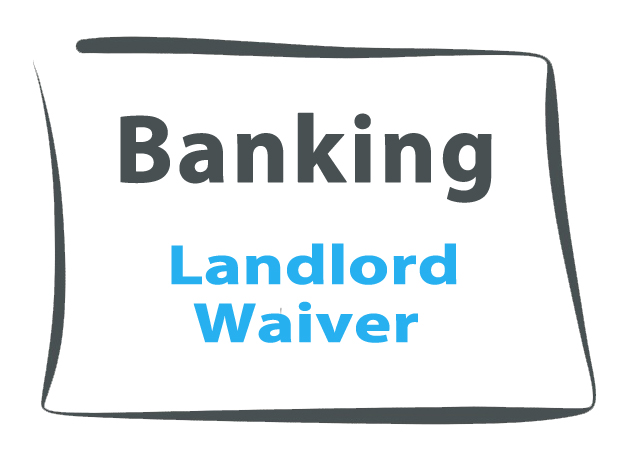Landlord Waiver (aka Landlord Waiver & Consent)
Not all businesses are fortunate enough to own the building or space where it operates and as such is required to lease its business premises. When that business goes to borrow money the Lender will generally want to know that the lease is in good standing and that lease or enforcement of that lease won’t jeopardize the business and the Lender’s security. Confirmation of these items is typically contained in a legal document known as a Landlord Waiver, which is also referred to as a Landlord Consent & Waiver. This agreement is signed by the borrower, the Lender, and the landlord.
In determining whether a Lender will require a Landlord Waiver as a condition of its financing, the Lender must consider how crucial the leased premises are to the operations of the business. Some businesses are more portable and can move their operations quickly to another space without any material costs or business interruptions – an example would include a services company that holds mainly office space and no real significant leasehold improvements, or a company that has inventory and operations that can be easily moved to another location. Other businesses are not as portable and cannot move their operations quickly to another space without any material costs or business interruptions – an example would include a manufacturing company which has heavy equipment attached to the premises or has had to incur significant leasehold improvements to their leased premises in order to conduct their operations. It is the latter where a Landlord Waiver becomes more important for a Lender.
What are the key elements of a Landlord Waiver and why are they important to a Lender?
1. Waiver of Distress
Distress is a remedy that gives a commercial landlord the right to seize the tenant’s goods from the leased premises and sell them to pay for rent in arrears. Aside from some exceptions (e.g. bankruptcy, PMSI, etc.), a landlord will have priority over a tenant’s goods if it completes its distress prior to a secured lender exercising its enforcement rights under a security agreement. Because of the risks this potential landlord priority poses, Lenders will often require the landlord to waive their right of distress in a Landlord Waiver. Landlords will often be opposed to waiving its rights to distress. Depending on the nature of the collateral of the borrower, a Lender may or may not want to go down this road.
2. Remedy and Cure
Another material risk to the continuity of a borrower’s operations and therefore a Lender’s security is an interruption of operations caused by the landlord enforcing a default under the lease. Piggybacking on the waiver of distress a Lender will want to have an opportunity to cure the default to prevent or at a minimum postpone the interruption. In these circumstances a Landlord Waiver would provide that the Landlord will give the Lender notice of the default and it will set forth a period of time within which the Lender can cure the default on the Tenant’s behalf. Failing to cure within the time period would permit the Landlord to distrain against the goods and terminate the lease if the default gives rise to this right.
3. Lender’s Access to Collateral
If a Lender is successful in obtaining the waiver of distress (as discussed above) then the natural next request would be to obtain the landlord’s consent to access the leased premises on default under the Lender’s security for the purposes of seizing the collateral and preparing it for sale. Depending on the nature of the collateral (e.g. heavy equipment) the Lender will require a longer amount of access to the collateral to ensure that it will have sufficient time to sell the collateral from the leased premises. The amount of time required would be less for collateral that can be moved easily and sold at a different location. Typically the Landlord will be entitled to compensation from the Lender for the duration of access as well as for any damage to the leased premises caused by the Lender during the removal and sale of the collateral.
4. Confirmation of Material Facts
(a) Lease. There are certain facts that a Lender will want to confirm with respect to the lease itself that are material to the continuity of the borrower’s operations in the leased premises. These include:
(i) confirmation that the borrower is not in default under the lease;
(ii) confirmation that the lease is in full force and effect and all amendments have been disclosed to the Lender;
(iii) confirmation that the Lender has seen a full copy of the lease together with all applicable amendments (this is usually accomplished by attaching a copy of the lease, as amended, to the Landlord Waiver; and
(iv) confirmation that the Lender’s security interest in the collateral does not constitute a breach under the lease.
(b) Collateral. If the collateral that is subject to the Landlord Waiver becomes fixtures it will be subject to different priority rules which would adversely affect the Lender in most situations. As such, a Landlord Waiver should include confirmation that the collateral remains personal property and will not become fixtures.
Conclusion
As is evident from above there are a number of benefits to obtaining a Landlord Waiver and for these reasons a Lender should consider making this a condition to its funding. Again, and as outlined above, this will depend on the circumstances of the borrower and the landlord as well as the portability of the business and its assets, and as such this determination will need to be made by the Lender on a case-by-case basis.

